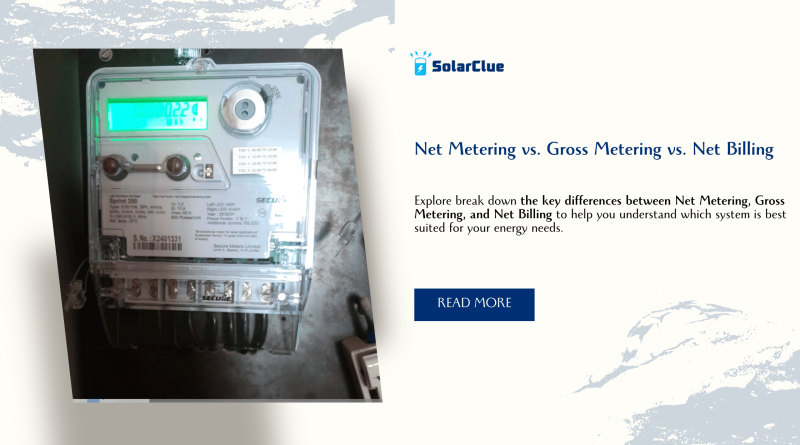Net Metering vs. Gross Metering vs. Net Billing
With the growing adoption of solar power and other renewable energy systems, consumers are often faced with several energy billing mechanisms that affect how they are credited or billed for the electricity they generate. The three primary systems used across the globe are Net Metering, Gross Metering, and Net Billing. Each system has its own advantages and operational mechanisms, which can influence both the financial and environmental benefits of solar energy generation.
In this blog, we’ll break down the key differences between Net Metering, Gross Metering, and Net Billing to help you understand which system is best suited for your energy needs.
Table of Contents
What is Net Metering?
Net Metering is a billing mechanism that allows consumers who generate their own electricity (usually through solar power) to offset the energy they consume from the grid by sending excess electricity back to the grid. The consumer is credited for the excess electricity exported, and the billing is based on the net energy used—i.e., the difference between the energy consumed and the energy generated.
Key Features of Net Metering:
Offset Electricity Bills: Consumers can offset their electricity consumption by the amount of energy they export to the grid.
Credit for Excess Energy: Any excess electricity sent to the grid earns credits that can be applied to future bills.
Monthly Settlement: The consumer is billed based on the net amount of electricity used over the billing period.
Example:
If a household generates 400 kWh of electricity through their solar system and consumes 500 kWh from the grid, they will be billed only for the net 100 kWh (500 kWh – 400 kWh).
What is Gross Metering?
Gross Metering is a system where all the electricity generated by the consumer’s renewable energy system is fed directly into the grid. The consumer is then paid a fixed tariff for the total electricity exported, but they still need to purchase their entire electricity consumption from the grid at the regular rate. This system treats the consumer’s energy production and consumption separately.
Key Features of Gross Metering:
Sell All Generated Power: All the electricity generated by the solar system is exported to the grid at a predetermined tariff.
Purchase Power from the Grid: Consumers must buy the electricity they use from the grid at the standard retail rate.
No Offsetting: The consumer’s electricity consumption and production are treated separately, without any netting off of energy used and produced.
Example:
If a solar system generates 400 kWh of electricity, all 400 kWh are sent to the grid. The consumer is paid for the 400 kWh at a set rate, but they must buy their electricity usage (say, 500 kWh) from the grid at the regular retail price.
What is Net Billing?
Net Billing is similar to net metering in that it allows consumers to generate their own electricity and export excess energy to the grid. However, the key difference is that the consumer is paid a pre-agreed rate (usually lower than the retail rate) for the electricity they export, rather than receiving a credit at the retail rate. Consumers are billed for their total electricity consumption, and they receive payment or credit for the excess electricity exported to the grid.
Key Features of Net Billing:
Lower Export Tariff: Consumers are paid at a lower tariff for the electricity they export to the grid.
Full Electricity Bill: Consumers are billed for the total amount of electricity consumed from the grid at the regular retail rate.
Compensation for Excess: The consumer receives compensation based on the quantity of electricity they export, but at a lower rate compared to net metering.
Example:
If a solar system generates 400 kWh of electricity, and the household consumes 500 kWh, they will be billed for the full 500 kWh at the retail rate. The excess 400 kWh sent to the grid will earn compensation at a lower agreed rate.
Key Differences Between Net Metering, Gross Metering, and Net Billing
Below is a detailed comparison table outlining the key differences between these three energy billing mechanisms.
Comparison of Net Metering, Gross Metering, and Net Billing
| Aspect | Net Metering | Gross Metering | Net Billing |
|---|---|---|---|
| Energy Consumption | Consumers offset their energy usage with the energy they produce | All energy generated is exported to the grid | Consumers use their generated electricity, excess is sold to grid |
| Energy Export | Only excess energy is exported to the grid | All generated energy is exported to the grid | Excess energy is exported to the grid |
| Credit/Payment for Export | Credits earned at retail rate for energy exported | Paid at a fixed tariff for total energy exported | Paid for exported energy at a lower rate than retail |
| Billing Mechanism | Billed for the net difference between consumption and generation | No offsetting, billed for total energy consumed from the grid | Billed for total consumption, paid for exported energy at a lower rate |
| Financial Benefit | Consumers can reduce or eliminate electricity bills | Consumers earn income from selling energy, but pay for usage | Consumers pay full bills, receive payment for exported energy |
| Ideal For | Consumers wanting to reduce electricity bills | Consumers wanting to generate revenue from energy production | Consumers looking for partial bill reduction and income |
| Energy Independence | Greater independence by reducing grid reliance | Full grid dependence for consumption | Partial grid reliance, with excess energy sold to the grid |
Which Billing Mechanism is Best for You?
The choice between net metering, gross metering, and net billing depends on your location, energy needs, and financial goals. Here’s a breakdown of which system might work best for you:
1. Net Metering: Best for Reducing Electricity Bills
Net metering is the best option for consumers who want to reduce their electricity bills. It allows consumers to generate and consume their own solar power, and any excess energy can be credited to future bills. Net metering is ideal for residential consumers and businesses looking for substantial savings on their electricity costs.
- Pros: Reduces electricity bills, allows full use of generated energy, monthly settlement.
- Cons: Availability may vary depending on state regulations.
2. Gross Metering: Best for Income Generation
Gross metering is suitable for consumers who want to generate revenue from solar power production. This system is often used for larger solar projects, such as solar farms or commercial installations, where the goal is to sell the energy produced to the grid.
- Pros: Generates a fixed income from selling energy, simple structure.
- Cons: Consumers must still purchase electricity at the regular rate, no offsetting.
3. Net Billing: Balanced Approach
Net billing offers a balanced approach between net metering and gross metering. Consumers can use the electricity they generate and are compensated for the excess energy exported to the grid at a lower tariff. This system is best suited for consumers who are not eligible for net metering but still want to benefit from generating and exporting solar energy.
- Pros: Generates some income from excess energy, provides partial bill reduction.
- Cons: Lower export tariffs than net metering, full bills for electricity consumption.
Conclusion
Choosing between Net Metering, Gross Metering, and Net Billing depends on your individual needs and energy goals. Net metering is ideal for those looking to reduce their electricity bills by using renewable energy, gross metering is a great option for those interested in generating revenue, and net billing provides a middle-ground for consumers wanting to benefit from both solar energy use and export. Each system offers unique financial and environmental benefits, so it’s essential to evaluate your options based on your energy consumption and the policies in your region.
Ready to Save on Electricity Bills with Solar Power?
With Net Metering, you can drastically reduce your electricity costs by generating your own solar power and sending any excess back to the grid. It’s time to harness the sun’s energy and make a positive impact on both your wallet and the environment!
At SolarClue, we make the transition to solar simple, efficient, and affordable. Whether you’re a homeowner, business, or institution, our team of solar experts will guide you through the process—from installation to maintenance—so you can start saving from day one.
🌞 Take the first step towards energy independence today!
🔋 Get your solar consultation now!
Contact SolarClue or call us at +91-888-4444-830 to explore the best solar solutions for your home or business.
Go Solar. Save More. Power Your Future with SolarClue!
FAQs
1. What is the main difference between net metering and gross metering?
Net metering allows you to offset your energy consumption with the energy you generate, while gross metering requires all the generated energy to be sent to the grid, and you are paid for it.
2. Is net metering available in all states in India?
No, net metering policies vary by state in India, and availability may depend on state regulations.
3. Can I switch between net metering and gross metering?
Switching between these systems depends on local policies and utility regulations. Some regions may allow switching, while others may not.
4. Which system is the most profitable?
It depends on your objectives. Gross metering is more profitable for income generation, while net metering offers the best savings on electricity bills.
5. What is the future of net billing in India?
Net billing is gaining popularity as an alternative to net metering, especially in regions where net metering is being phased out or restricted due to grid constraints.


